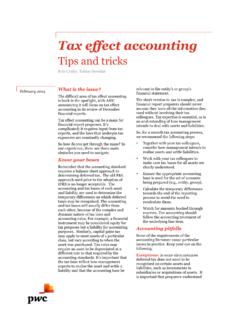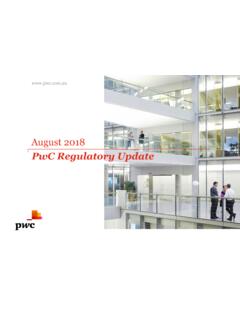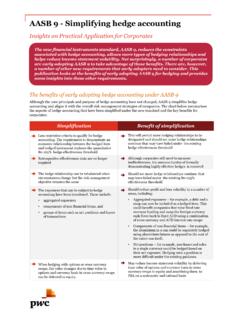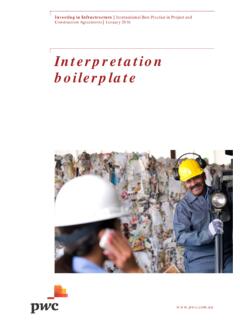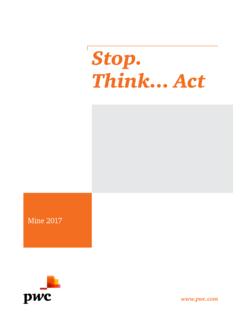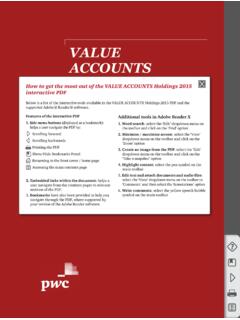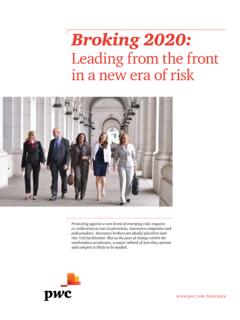Transcription of Hybrid mismatch and low tax rate lender rules introduced ...
1 taxtalk Insights Corporate Tax Hybrid mismatch and low tax rate lender rules introduced into Parliament 28 May 2018 Explore more insights In brief On 24 May 2018, legislation was introduced into Federal Parliament to give effect to the Organisation for Economic Co-operation and Development s (OECD) recommended Hybrid mismatch rules , as originally announced by the Australian Government in May 2015. Hybrid mismatches are differences in the tax treatment of an entity or instrument under the laws of two or more tax jurisdictions. If a mismatch arises, it is neutralised by disallowing a deduction or including an amount in assessable income. The measures broadly apply in the same manner as the exposure draft law released on 7 March 2018, which was an update to the incomplete draft law previously released for comment on 24 November 2017.
2 However, there have been some changes following public consultation. For further background on these exposure drafts, refer to our taxtalk Alerts published on 9 March 2018 and 27 November 2017 respectively. The legislation includes a more refined integrity rule designed to prevent multinational groups from using interposed conduit type entities that effectively pay no tax to invest in Australia, as an alternative to investing into Australia using Hybrid entities or instruments. The integrity rule is a unilateral measure, first announced by the Treasurer in November 2017, and is a key departure from OECD recommendations in relation to Hybrid mismatch arrangements. The legislation will generally apply to income years starting on or after 1 January 2019.
3 Restrictions on the foreign dividend participation exemption will apply to distributions made on or after 1 January 2019. However, the imported mismatch rule (other than for structured arrangements) will apply to income years starting on or after 1 January 2020. Background The introduction of rules in Australia designed to eliminate Hybrid mismatch arrangements was foreshadowed by the Australian Government in the May 2015 Federal Budget when it asked the Board of Taxation (BoT) to consult on the implementation of Hybrid mismatch rules developed by the OECD under Action 2 of the Base Erosion and Profit Shifting (BEPS) Action Plan. PwC Page 2 Based on OECD recommendations released in September 2014, and finalised in October 2015, along with the BoT recommendations accepted by the Government, the Hybrid mismatch rules were originally intended to apply to all payments made on or after the later of 1 January 2018 or six months after the relevant law was enacted.
4 The start date of the measures is now certain under the legislation that is currently before Parliament. Following additional consultation conducted by the BoT, the Australian Government announced in the May 2017 Federal Budget that the Hybrid mismatch rules would also apply to regulatory capital of banks and financial institutions. The OECD released a draft report in relation to branch mismatch arrangements in August 2016, which was finalised in July 2017. Some of these recommendations have been incorporated into the legislation. A number of countries, including Germany, Japan, Mexico, Netherlands, Norway and South Africa, have implemented Hybrid mismatch rules but none of these align with the full OECD recommendations.
5 The United Kingdom introduced Hybrid mismatch rules , with effect from 1 July 2017, largely based on the OECD recommendations. The United States has introduced limited Hybrid mismatch rules applicable from 1 January 2018. New Zealand has introduced legislation into Parliament which includes OECD-style Hybrid mismatch rules applicable from 1 July 2018. Twenty eight EU member states plan to introduce Hybrid mismatch rules from 1 January 2020. In detail The Bill, Treasury Laws Amendment (Tax Integrity and Other Measures No. 2) Bill 2018 (including 96 pages of law and 133 pages of explanatory material), which seeks to implement the Hybrid mismatch rules into Australia, generally incorporates the key elements of the last exposure draft material released in March 2018, with some welcome changes and clarifications.
6 We note that these measures are broadly consistent with the OECD recommendations, but there are some departures which will be important to understand. The rules are complex and require an enquiry into the operation of foreign tax rules . The legislation is expected to have an unquantifiable gain to revenue over the forward estimates period . It is recognised that the legislation will impose compliance costs as taxpayers will be required to obtain sufficient information to identify and assess the expected tax treatment of instruments or entities in a foreign counterparty jurisdiction. However, the Government concludes that in most cases parties to a cross border arrangement would be aware of, or be able to obtain information about, the counterparty tax treatment.
7 In simple terms, the Hybrid mismatch rules seek to neutralise circumstances where cross-border arrangements give rise to payments (including, for example, interest, royalties, rent, dividends and, in some cases, amounts representing a decline in the value of an asset) that: 1. are deductible under the tax rules of the payer, and not included in the income of the recipient (deduction/no inclusion or D/NI outcome ); or 2. give rise to duplicate deductions from the same expenditure (double deduction or DD outcome ). If an arrangement gives rise to a D/NI or DD outcome, the Hybrid mismatch rules operate to eliminate the mismatch by, for example, denying a deduction or an income exemption (including franking credits).
8 The rules mechanically allocate the taxation right in relation to a mismatch . The purpose of the arrangement, generally, should not affect the outcome. For example, a tax deduction could be denied in Australia for royalties or interest paid to a foreign entity because that foreign entity is not taxed on the income it receives as a result of that foreign entity satisfying the definition of a Hybrid entity. This denial would apply despite the Australian taxpayer satisfying other PwC Page 3 rules ( transfer pricing and thin capitalisation) and the income being subject to Australian (withholding) tax. The Hybrid instrument rules could apply where, for example, an Australian company receives dividends from a foreign subsidiary.
9 In this case, the Australian dividend exemption may be denied if the foreign subsidiary was afforded a foreign tax deduction for the dividends paid to Australia. In addition, the legislation includes imported Hybrid mismatch rules which, in essence, seek to reduce or eliminate tax deductions for payments made by an Australian entity which directly or indirectly fund a Hybrid mismatch outcome in any country that has not adopted OECD Hybrid mismatch rules . These rules can operate to deny deductions in Australia for a broad range of payments including rents, royalties, interest, the purchase of trading stock and fees for services. Imputation benefits may be denied if a foreign income tax deduction is available in respect of a distribution.
10 A transitional rule will be available for regulatory capital of an authorised deposit-taking institution or insurance company that was issued before 9 May 2017. The legislation also addresses branch mismatch arrangements. The proposed measures will: Limit the foreign branch exemption ( section 23AH of the Income Tax Assessment Act 1936) in respect of branch Hybrid mismatches. In broad terms, a branch Hybrid mismatch arises where the residence country provides a branch exemption, but the branch country does not tax the payment because the payment is treated as not derived in carrying on business through a permanent establishment. Disallow a tax deduction for payments that give rise to a branch Hybrid mismatch for the payee.
